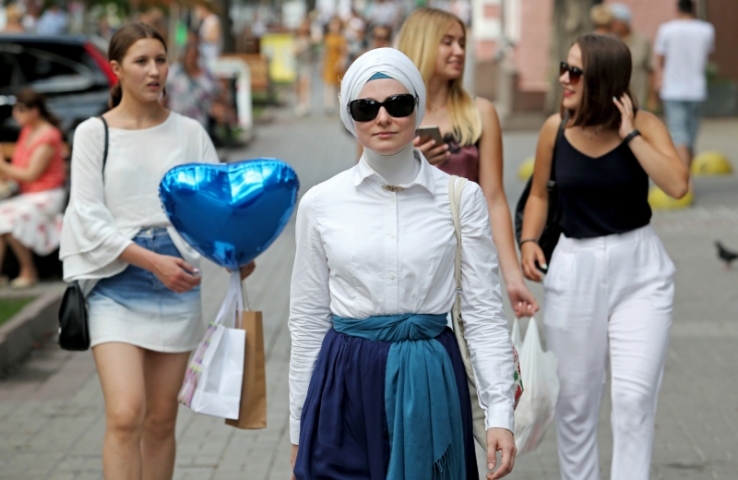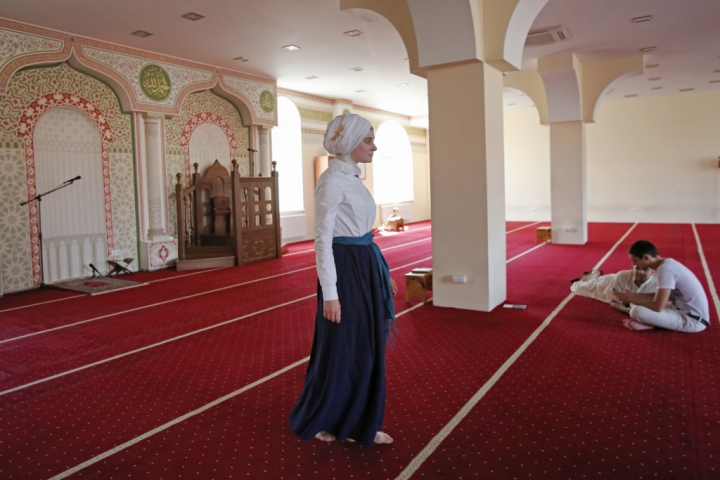Editor’s Note: This article is a part of the “Journalism of Tolerance” project by the Kyiv Post and its affiliated non-profit organization, the Media Development Foundation. The project covers challenges faced by sexual, ethnic and other minorities in Ukraine, as well as people with physical disabilities and those living in poverty. This project is made possible by the support of the American people through the U. S. Agency for International Development and Internews. Content is independent of the donors.
When Ukrainian artist Mariam Nayyem decided to perform a social experiment and wear a headscarf for a week, she noticed with a surprise that people’s attitude towards her didn’t change.
Nayyem, whose family is from Afghanistan, has faced aggressive behavior from far-right groups several times because of her appearance. When she started her experiment in May, she expected that by wearing the hijab, or Islamic headscarf, she might face even more prejudice or aggressive behavior.
However, the result was completely the opposite.
In her blog at Ukrainian website Platforma she wrote that “in Kyiv people are ready to accept other cultures.” In contrast with her expectations, during those seven days “everyone was polite,” and she “didn’t feel any hatred.” Nayyem also realized that she had preconceptions as well – about how tough it might be for women to wear the hijab in Ukraine.
However, some Muslim women say they still face prejudice. The Kyiv Post spoke to four women who wear the Islamic headscarf about their life in Kyiv.
On the streets
The hijab is not to be confused with a simple headscarf: The hijab is part of a general rule mentioned in Quran that mandates which parts of the body should be covered. The term can refer to any head, face, or body covering worn by Muslim women.
To fit the term, the clothes have to cover the body down to wrist and feet, be modest, non-transparent, and not tight-fitting.
At same time, the style of hijab depends on the cultural traditions and personal choices of the person who wears it.
Tetiana Evloeva, who converted to Islam more than 10 years ago, said that some Ukrainian traditional outfits also fit the criteria of the hijab, as they usually cover the body and hair. Evloeva’s outfits are often inspired by folk or traditional costumes.
“I realize that I do look exotic in a city of people in T-shirts, but not too exotic – my style is more or less acceptable to locals,” she said.
Evloeva said that in most cases she doesn’t feel any aggression or harassment from people on the streets, except very rare negative comments on public transport.
“Once, I sat on the bus next to Greek-Catholic nun. We smiled at each other, but other people on the bus were staring at us as if we might start fighting,” she said.
“Another time when I took the bus, there was a woman who started screaming that she doesn’t want to be on the same bus with me,” Evloeva recalled.
Crimean Tatar Arzy Kurtbedin, who has worn a headscarf for four years, said that in Kyiv people are much more tolerant than in her homeland of Crimea.
Kurtbedin, 29, lived in Kyiv periodically from 2013, but moved to the capital from Simferopol permanently in 2016. She said that the attitude to Muslim women and to Crimean Tatars in general has worsened since Russia invaded and occupied the Ukrainian territory in 2014.
Kurtbedin also said that she had never experienced any violence in the capital, but there had been some unpleasant situations in which older people had sworn at her in the streets.
‘Poor’ and ‘oppressed’
Nevertheless, Evloeva said that there is a popular stereotype that Muslim woman are “oppressed” and “forced” to wear a headscarf.
“Almost every person that I meet for the first time without ever having talked to me before thinks that being Muslim and wearing the headscarf is anything but my choice,” Evloeva said.
“They think if you are Muslim and you are wearing modest clothing it’s the choice of your parents, of your husband, or of anyone but you. They don’t come and ask why you were wearing this (a headscarf). They ask: ‘Who makes you wear it?’”
“Some people become outraged when they think that someone is making me wear more clothes, but at the same time they think they are entitled to make me wear fewer clothes. But in both cases my free will is being restricted,” she said.
“I don’t tell people what to wear. Why do they think they are in position to tell me what should I wear?”
“When a stranger comes to me and denies that I am a human being with my own wishes – this is very humiliating.”
Problems for converts
Evloeva, whose family is from western Ukraine, was brought up in Greek-Catholic family. She said that she had always been religious as a child, but Christianity couldn’t answer all of the questions she had. When she was 18, attending university, Evloeva converted to Islam, but it took her several years to tell her parents and to start wearing the hijab at home.
“I have never argued with my parents about religion, but they were worried that I wouldn’t find my place in life if I wore the headscarf,” she said. “They were afraid that I wouldn’t find a husband, would not build a career, and wouldn’t have any friends.”
But Evloeva said that after a while, when they saw that their daughter was doing well, her parents stopped worrying.
Marina Kiselyova, 33, who converted to Islam three years ago, faced similar problems.
Kiselyova said that at first her mother tried to discourage her from being Muslim, and even refused to walk on the same side of the street when they took a walk together.
Kiselyova, a native of Donetsk, said that her mother was also worried about her daughter’s safety, because Kiselyova started wearing a headscarf in 2014, when war erupted in the eastern Ukraine and people were frequently kidnaped in Donetsk.
However, Kiselyova said that her mother changed her opinion after they left Donetsk and moved to Kyiv together. Now her mother works in the school in the capital’s Islamic Cultural Center.
Evloeva said that the relatives of new converts often have negative stereotypes about Islam, and that many of them are afraid that their loved ones might be dragged into some radical religious organization. She also said that she knew people who were even driven out of their homes when they became Muslims.
At work
Syrian-born Rula Al-Shadat, 29, who has worn the headscarf for more than 11 years, has had problems because of it in Ukraine twice in her life.
Once, she was asked to take off a headscarf by the pro-rector of the university where she studied in Kyiv, when she and other two students were supposed to give a speech at their graduation ceremony.
But Al-Shadat didn’t back down. Instead, she went to the rector and said that giving a speech at the ceremony wasn’t worth taking off her scarf. In the end, she gave her speech while wearing a headscarf.
However, the other Muslim girl who was also to give a speech was forced to take off her scarf.
The second time Al-Shadat faced prejudice happened when she was looking for a job.
After she qualified as a dermatologist, she sent her resume, which didn’t have a photo, to several clinics, and they immediately called her back. However, when she came to interviews employers reacted badly to her headscarf, according to Al-Shadat.
In the end, she got a job at a clinic owned by a foreigner.
However, Al-Shadat said after a year the other clinics got back in touch with job offers. She said it happened after her clinic published statistics on a number of patients it had treated, it turned out that Al-Shadat had treated more clients than her Ukrainian colleagues at the same clinic.
Meanwhile Kurtbedin, who is now on maternity leave, said that the manager of the clothing store where she worked as a cashier fired her when she started wearing the headscarf at work.
“She just told me that she would feel ashamed in front of her customers if a person in a headscarf was working in the shop,” Kurtbedin said.
Kiselyova, who worked in a bank, said that she couldn’t wear the headscarf at her job because they had a strict dress code. After some time she transferred from the sales department to the call center, where she could wear anything she wanted.
So while freedom of religious expression is enshrined in Ukraine’s constitution, Muslim women have mixed experiences of respect for their rights in the country.
“I think that Muslim women (still) have to fight for our rights,” Al-Shadat said.
“You need to show that you are not to be pitied. You need to show them that you are wearing the hijab for yourself – not for your husband or children, but because it’s in accordance with your beliefs,” she said.
By Anna Yakutenko
Source: KyivPost




